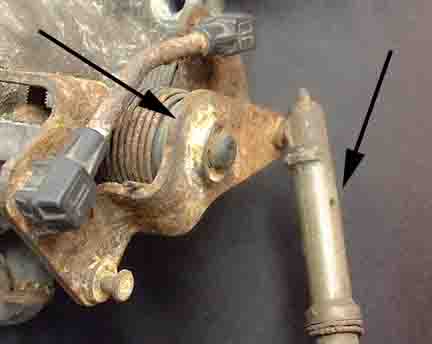THROTTLE MECHANISM FAILURE ANALYSIS
By
Charles C. Roberts, Jr., Ph. D., P.E
Statements by an insured that the accelerator pedal stuck and
caused an automobile accident are not unusual. Although many
such claims are unfounded, some do, indeed, have technical merit.
In one instance, an insured was driving a van when the accelerator
pedal did not return to the closed throttle position. Repeated “jabs”
to the pedal did not rectify the condition. The claimant then
jumped from the vehicle, which, apparently, did not cause serious
injury. The vehicle continued forward, starting to turn slowly in a
circle, traveling over curbs and a vacant field. The serious injury to
the claimant occurred when the vehicle circled back and ran over
the claimant. Witnesses indicated that the vehicle was traveling
about 20 mph - attesting to the theory that the vehicle throttle was
at least partially open. The vehicle was inspected and disassembled
in the presence of interested parties. During the inspection, it was
noted that the throttle was about 1/3 open and did not return to the
closed position. There were no obstructions that could have
prevented the return, other than some problem in the throttle
linkage system. The throttle body and throttle cable were removed
for inspection.

Figure 1
Figure 1 is a close-up of the throttle bellcrank and throttle cable
assembly. The right arrow is the throttle cable assembly.The left
arrow is the bellcrank that operates the throttle plates, controlling
engine speed. The throttle cable attachment point on the bell crank
would not swivel as originally designed. Figure 2 is a view of the
system with the throttle cable assembly removed.

Figure 2
In Figure 2 the left arrow points to the bell crank ball stud. The
right arrow points to the cable attachment point. Severe corrosion
was found in the ball joint cavity. Apparently, the ball stud
corrosion did not allow free movement of the ball joint
mechanism, resulting in the accelerator system not returning to the
closed throttle condition. The corrosion induced failure mode of
this system resulted in intermittent failure to return to the closed
position. The stickiness of the accelerator could vary depending on
time of year, corrosion rate and vehicle usage. The vehicle
involved was about 6 years old. Typically, joints of this type are
maintenance free for the life of the vehicle. In this case, there
appeared to be either a manufacturing or design, corrosion-related,
deficiency that caused premature accelerator linkage failure.

